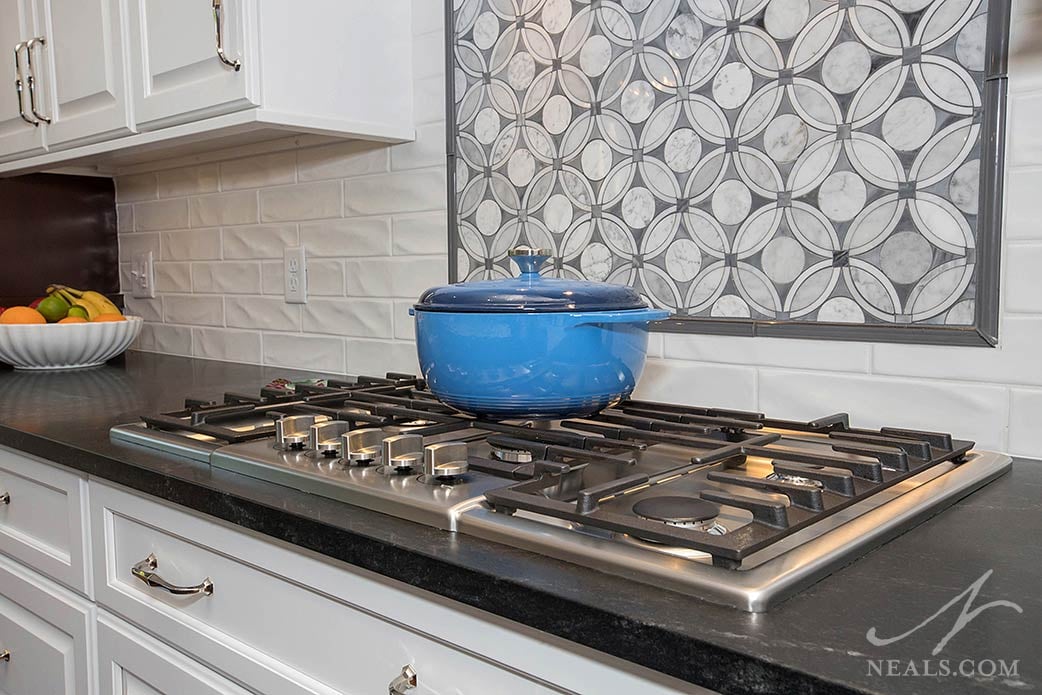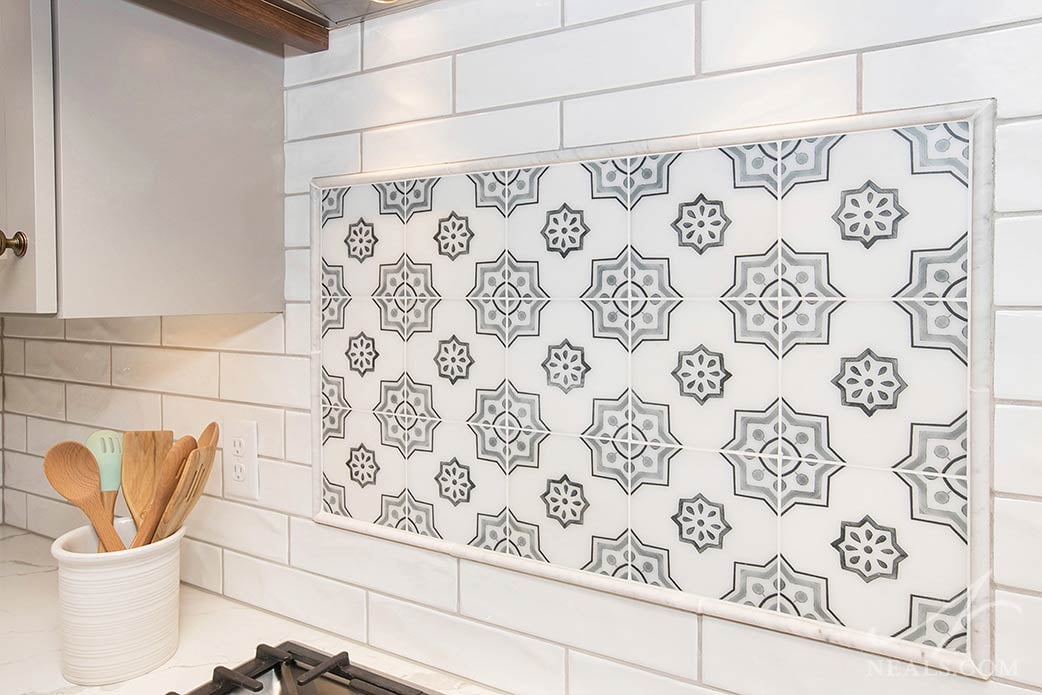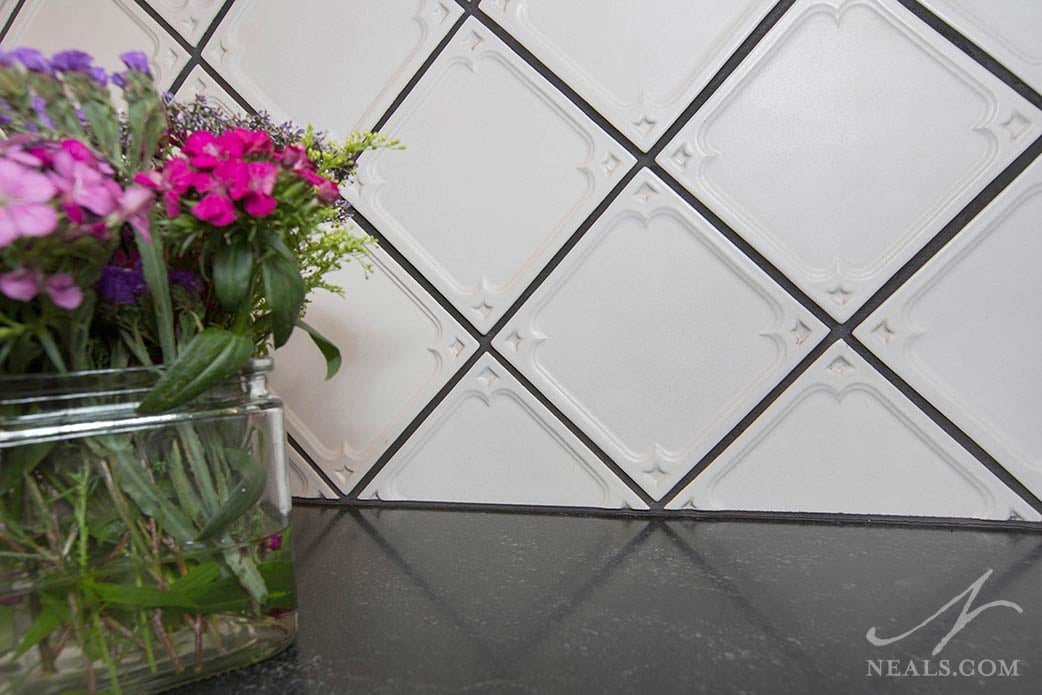A kitchen tile backsplash is often a focal point in the room and complements cabinetry and appliances. A tile backsplash is an architectural element that defines the décor style of a kitchen i.e., contemporary, traditional, transitional. In this post, we'll primarily be looking at tile as it applies to your backsplash, but tile could also used for kitchen flooring and sometimes counter surfaces. The design and material choices you will make are important. It is helpful to work with a kitchen designer because the shape of walls and the size and placement of cabinets, the sink and appliances will impact the design. When planning a tile design for your kitchen remodeling project, there are four primary things to consider.
1. Overall Tile Scheme
When planning a tile design for your kitchen backsplash you’ll want to first consider a field tile. Field tile is the predominate tile that will be used in the design. It can be natural stone, ceramic, porcelain, concrete, metal, glass, or a mixture. There are some classic field tile patterns that you can consider, as well as unique installations that your designer can help design with you. We recommend a trip to a tile showroom if you need ideas.
If you go with a tile mixture, the pattern may be set for you already in the mixture design. Pre-made tile mosaic mixtures typically comes pre-arranged on webbing to speed up the installation. If you’ve chosen a specialty tile, though, expect to add extra to your budget for the labor to install each tile individually.
Not all tiles need to be squares or rectangles. Tiles can also be round or oval, diamond shaped, hexagons, or even unique shapes designed to fit together in unique ways. Waterjet cutting technology also lends itself to tile design, making complicated tile patterns easier to produce. Finally, large-scale, multi-colored designs painted or printed on tiles can be a show-stopping backsplash option.
Accent tile can also be added to your backsplash design and can include border tile or contrasting tiles used within the field pattern. You might consider painted tiles, tiles with 3-dimensional designs, or one-of-a-kind artisan tiles as accents. A small-scale tile that might typically be considered for an accent may instead be be used as a field tile on its own, so don't discount that option.
2. Tile Arrangement
Any field tile you select may come with more than one way to install it in terms of orientation and arrangement. There are several common pattern arrangements that can be used, as well as unique installations that your designer can assist you with. Classic patterns can be used for most rectangular tiles. While the basic pattern is a simple grid, there are others that are commonly used. Rectangular tiles can be arranged in a brick pattern, sometime also known as a "subway tile" design. Square tiles can be arranged in a diagonal or diamond pattern. Another popular option is a herringbone pattern, which uses rectangular tiles in columns or rows of "V"s.

Kitchen Remodel in Monfort Heights
3. Accent Panels
In most kitchens, the wall space above the cooktop is a larger open spot that may look bare or boring if only covered with the field tile (though this is primarily based on the tile in use and of course your personal style preferences). In that case, an accent tile panel may be installed that adds interest and a focal point, similar to a piece of art. This is a good spot to add more color and pattern to the backsplash, and to tie into the room's entire design through the colors and shapes in the tile you select. This is also a nice way to add a small amount of a tile that you love, but that may too cost prohibitive to install as a full backsplash. Popular options are mosaic tile mixes or waterjet cut panels with individual tiles that fit together to form a design. Whatever option you select here, it's important that it works visually well with the tile you select for the rest of the backsplash so that the two aren't competing or clashing.
4. Grout Thickness & Color
Often overlooked until needed, but a crucial element to the tile design of your kitchen, is the grout. Grout is the compound that fills the space between tiles, and even with tiles that are installed very close together, grout will be used to ensure that the tile surface is solid and filled in. Grout comes in many colors so that it can blend into the tile design or stand out. There are also multiple shades of the standard whites and grays so that if you're looking for a near seamless color match, you can probably find it. The thickness and color of the grout used will be a part of the way the tile looks. A thin matching grout line will allow the tile to stand on its own. A thick or contrasting grout will highlight the pattern of the tile and change the way the tile is perceived. The characteristics of the grout you opt for should be well considered with your designer.
Note: This post was originally published in 2013. It was last updated Feb. 9, 2021 with new photos and edited for better information and clarity.















